Picture this: a comprehensive document that neatly organizes and presents all your financial details in one place. Sounds too good to be true? Well, the AIS does just that! It is like having a personal financial assistant at your fingertips, helping you gain a clear understanding of your financial standing for a specific tax year.
But what exactly is the AIS, and why is it so important?
In this blog post, we will understand everything about Annual Information Statement, exploring its purpose, benefits, and how it empowers you to make informed financial decisions.
What is AIS?
AIS stands for Annual Information Statement. This document provides taxpayers with a comprehensive overview of their financial information for a specific tax year. The AIS includes details such as securities transactions, interest income, dividends, overseas remittances, bank transactions, credit card transactions, mutual fund transactions, and demands/refunds.
It is based on Form 26AS, a consolidated tax statement that includes tax information deducted at source (TDS), tax collected at source (TCS), and other tax payments made on behalf of the taxpayer. The AIS aims to provide taxpayers with complete and accurate information, encourage voluntary compliance, and deter non-compliance. Taxpayers can provide feedback on the information displayed in the AIS to correct any errors or discrepancies.
Key Features of Annual Information Statement (AIS)
The Annual Information Statement (AIS) offers several key features for taxpayers:
- Comprehensive Data: The AIS includes important financial information like interest income, mutual fund transactions, dividends, international remittances and securities transactions.
- Simplified Summary: The AIS generates a concise Taxpayer Information Summary (TIS) by eliminating duplicate data. This summary makes it easier for taxpayers to file their returns.
- Annual Information Statement Download Options: Taxpayers have the flexibility to download their AIS data in different formats such as PDF, CSV and JSON. This enables them to save and use the information as needed.
- Online Feedback: Taxpayers can provide feedback on the AIS data through an online platform. This allows them to report any errors or discrepancies in the information provided.
- AIS Utility: AIS utility is a user-friendly platform that allows taxpayers to access and review their AIS. It also provides a means to provide feedback on the data.
- AIS Mobile App: The AIS mobile app allows taxpayers to conveniently view and provide feedback on their AIS using their smartphones or tablets.
What Does Annual Information Statement (AIS) Consist?
PART A – General Information:
This section includes general details about the taxpayer, such as PAN (Permanent Account Number), Masked Aadhar Number, Name, Date of Birth/Incorporation/Formation, mobile number, email address, and taxpayer’s address.
PART B – TDS/TCS Information:
Here, you will find information related to tax deducted or collected at source. This includes the Information code, Information description, and Information value for each TDS/TCS entry.
- SFT Information: Under this category, you can view information received from reporting entities as per the Statement of Financial Transaction (SFT). This includes the SFT code, Information description, and Information value.
- Payment of Taxes: Details of tax payments made under different categories, such as Advance Tax and Self-Assessment Tax, are displayed here.
- Demand and Refund: You can access information about any tax demand raised or refund initiated during the financial year, including Assessment Year (AY) and amount. Note: (Details related to Demand will be released soon).
- Other Information: This section provides details from various sources, such as data related to Annexure II salary, Interest on refund, Outward Foreign Remittance/Purchase of Foreign Currency, and more.
The image above shows details about your account, such as the account number, type, and status. You can also see the source code and how much interest you earned from your savings account. Additionally, it provides information about securities transactions, like the date of sale or transfer, the type of security, and how many transactions you made. This helps you understand your financial activities better and keep track of your accounts and investments.
Check: How to Check Income Tax Refund Status Online?
How to Check Annual Information Statement?
Step 1: Log in to the income tax e-filing portal at www.incometax.gov.in. Go to the ‘Services’ tab and select ‘Annual Information Statement’ to check your AIS.
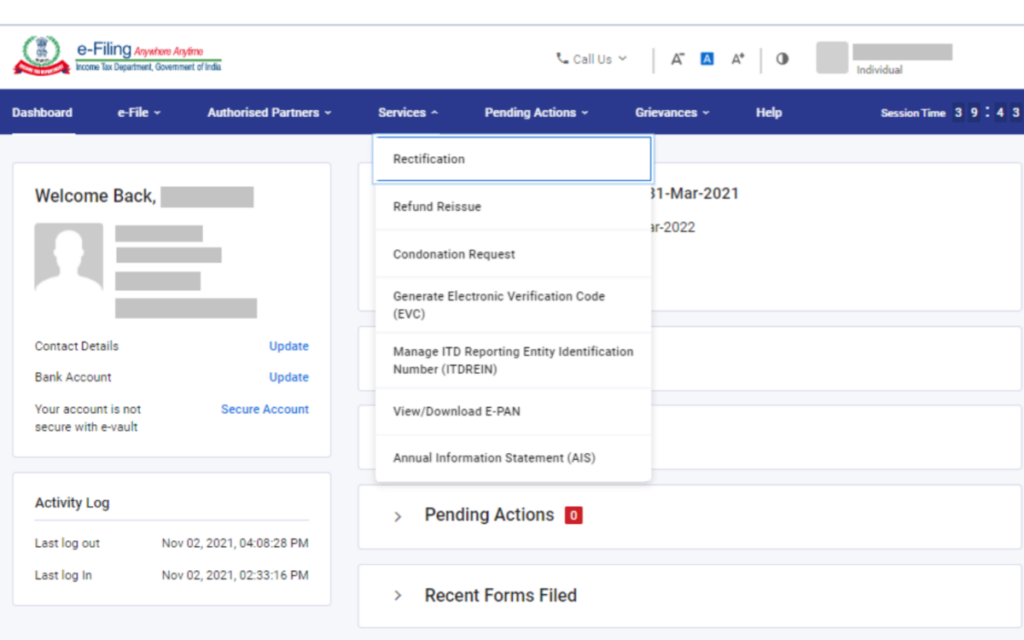
Step 2: Click on the ‘Proceed’ button to continue.
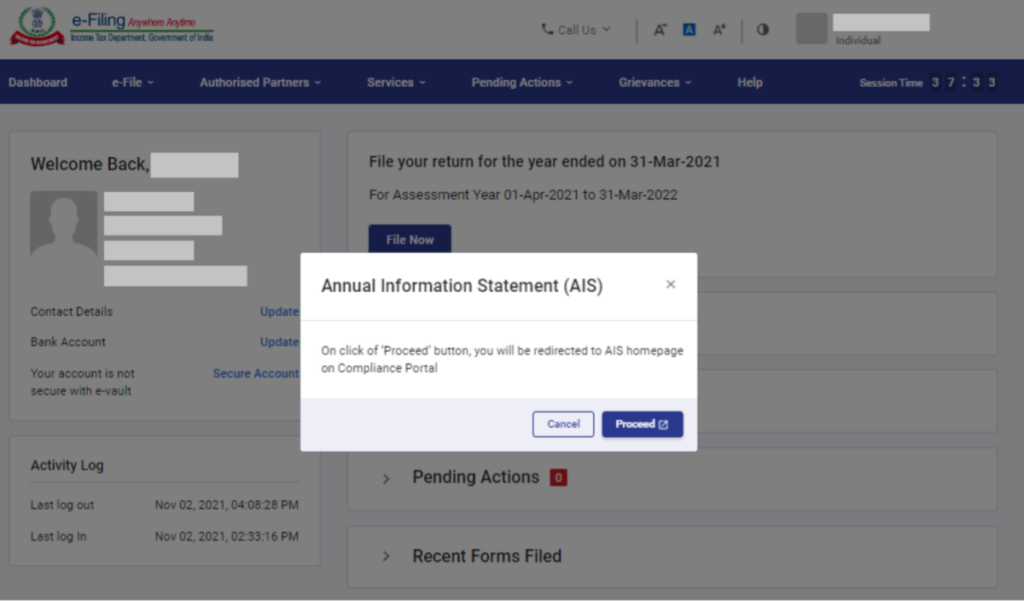
Step 3: You will be redirected to the compliance portal, where you can find the AIS home page. On this page, you can view the Taxpayer Information Summary (TIS) and Annual Information Statement (AIS).
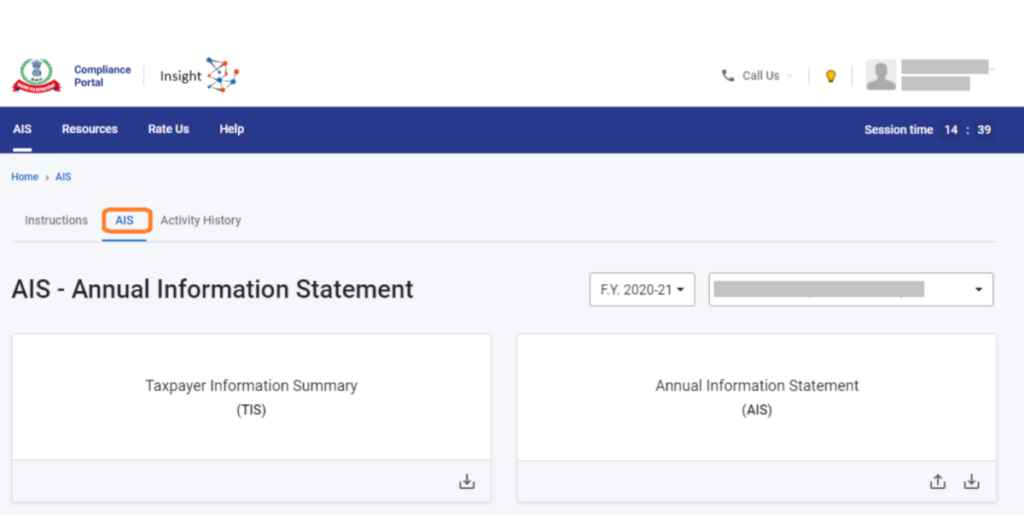
Step 4: Select the financial year and click on the respective tiles for the TIS or AIS to view the desired information.

Step 5: To download the AIS or TIS, simply click on the download icon provided in the respective tiles. The TIS can be downloaded in PDF format, while the AIS is available in both PDF and JSON formats.
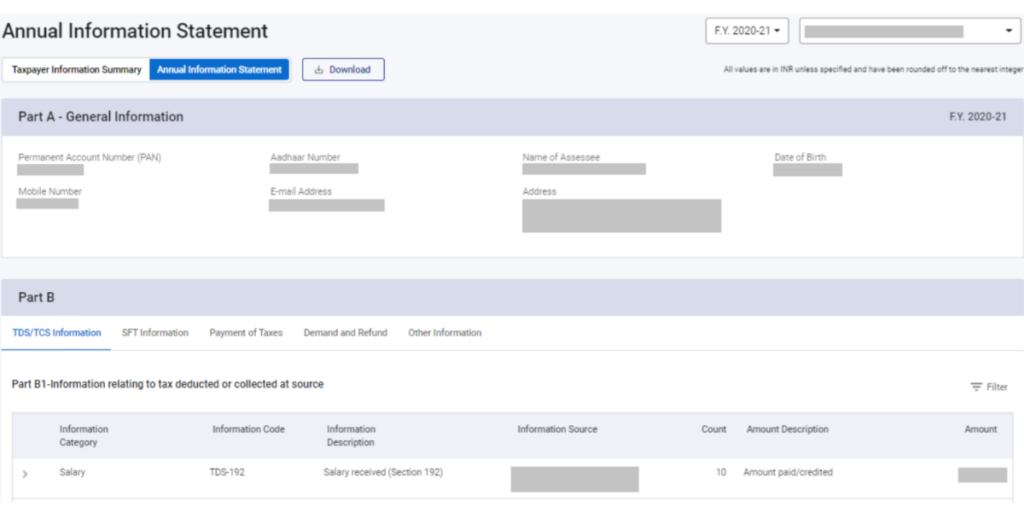
What is AIS Document Password?
If you download the PDF file, it will be password-protected. To open your AIS pdf, enter the password as follows:
For individual taxpayers:
- Use your PAN (in lowercase) and your date of birth.
- The date of birth should be in the format DDMMYYYY without any spaces.
For example, if your PAN is BBBB5678B and your date of birth is 15th March 1990, your AIS password will be bbbb5678b15031990.
What Steps Should Be Taken if an Error is Found in the AIS?
If you come across any errors in the Annual Information Statement (AIS) or Form 26AS, here’s what you should do:
- Understand the AIS: The AIS contains information available to the income tax department that is reported by certain entities as per the Income Tax Act. However, there may be instances where data for a specific period still needs to be received or updated. Therefore, it’s crucial to review all relevant information and ensure accuracy while filing your income tax return.
- Report Errors: If you identify any errors in the AIS, it’s important to report them using the feedback mechanism provided. This will help rectify any discrepancies and ensure that your income tax return reflects the correct information.
- Avoid Underreporting: It’s worth noting that the income tax department has identified cases where there is a mismatch between the AIS and the Income Tax Return (ITR). This mismatch can be considered as an underreporting of income, which may lead to penalties and interest payments. By rectifying any errors in the AIS, you can avoid potential consequences.
Know: How to file Income Tax
How to Submit AIS Feedback?
Step 1: Log in to your e-filing account on the official website of the Income Tax Department at https://www.incometax.gov.in/iec/foportal/.
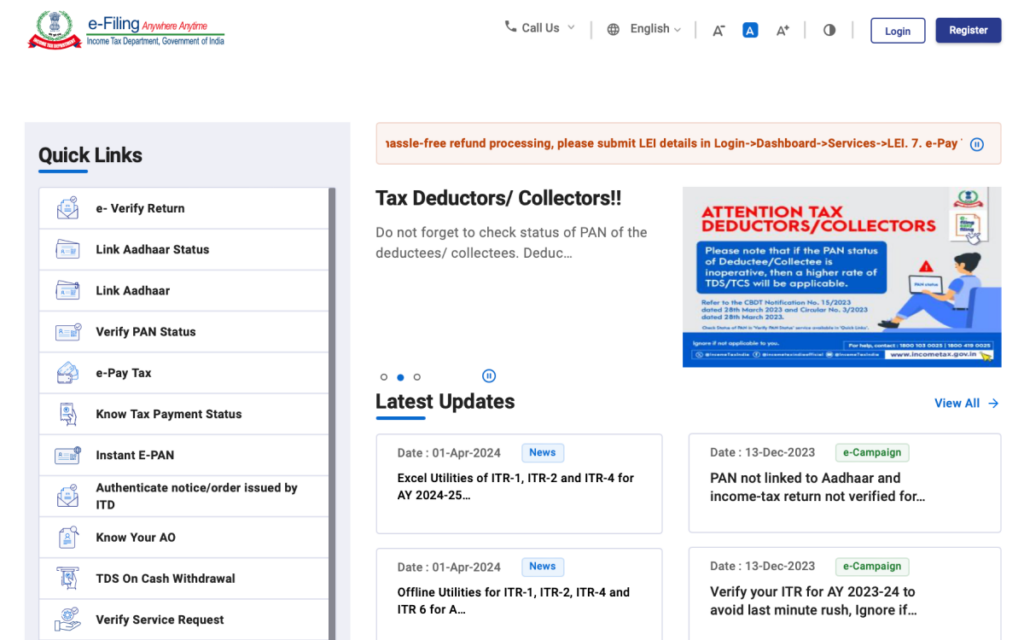
Step 2: Under the Service tab, select “Annual Information Statement (AIS)”.
Step 3: Click on AIS and identify the information that is incorrect or needs to be addressed.
Step 4: Select the “Optional” option to submit your feedback. Choose the appropriate option from the drop-down menu that best describes the issue.
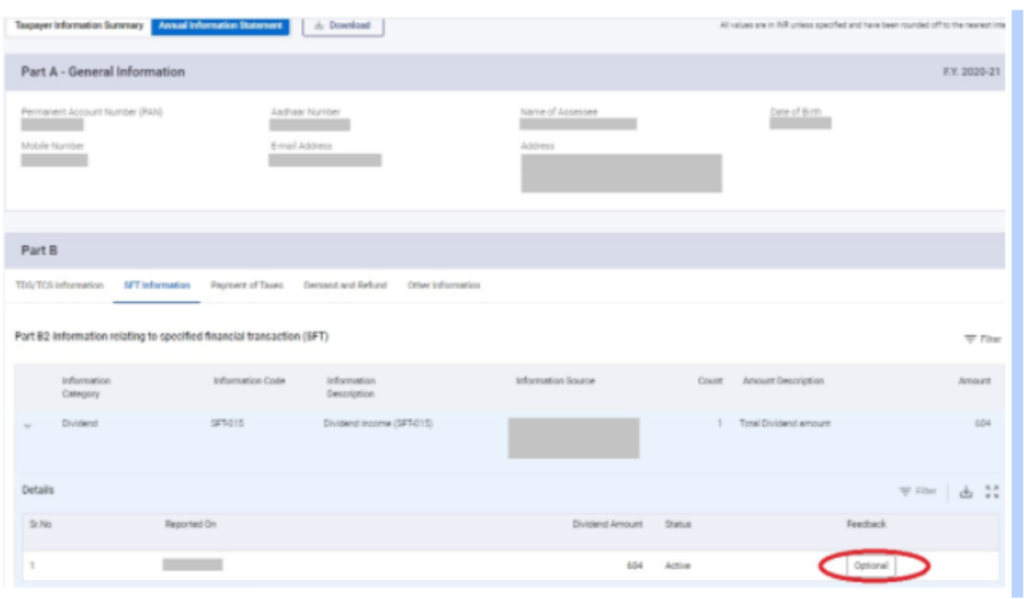
Step 5: Provide the necessary details related to the feedback or correction.
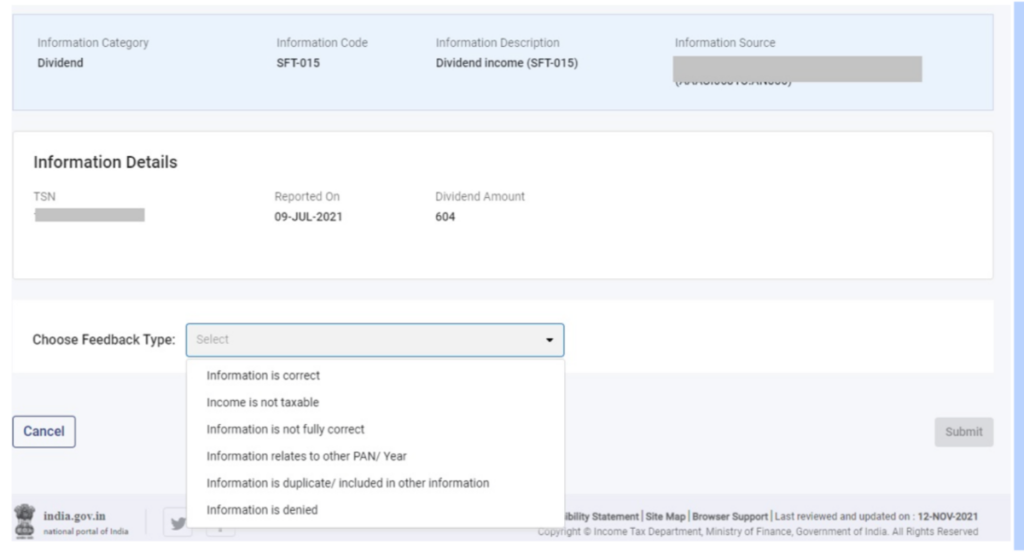
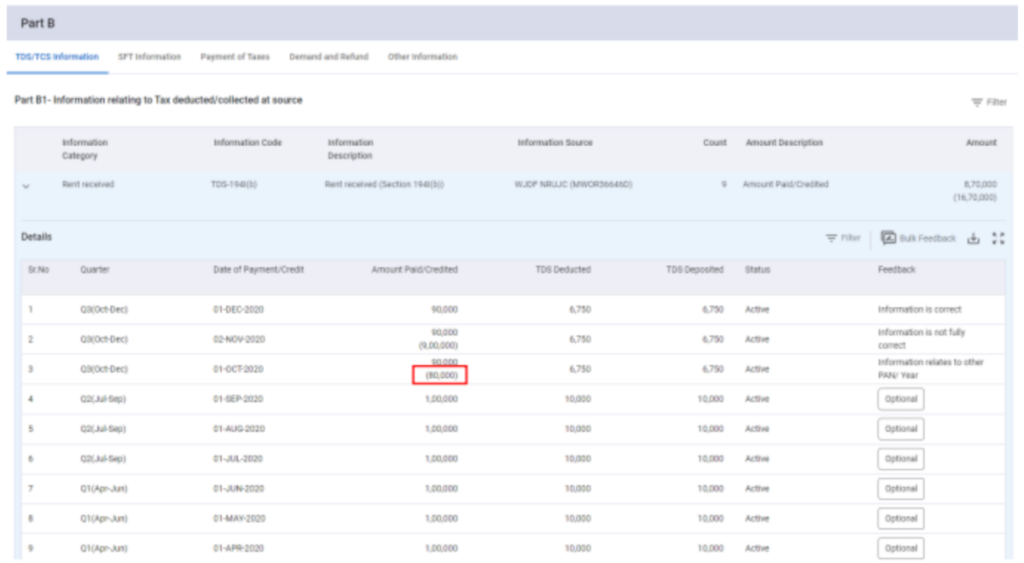
Step 6: Click on the “Submit” button to send your feedback.
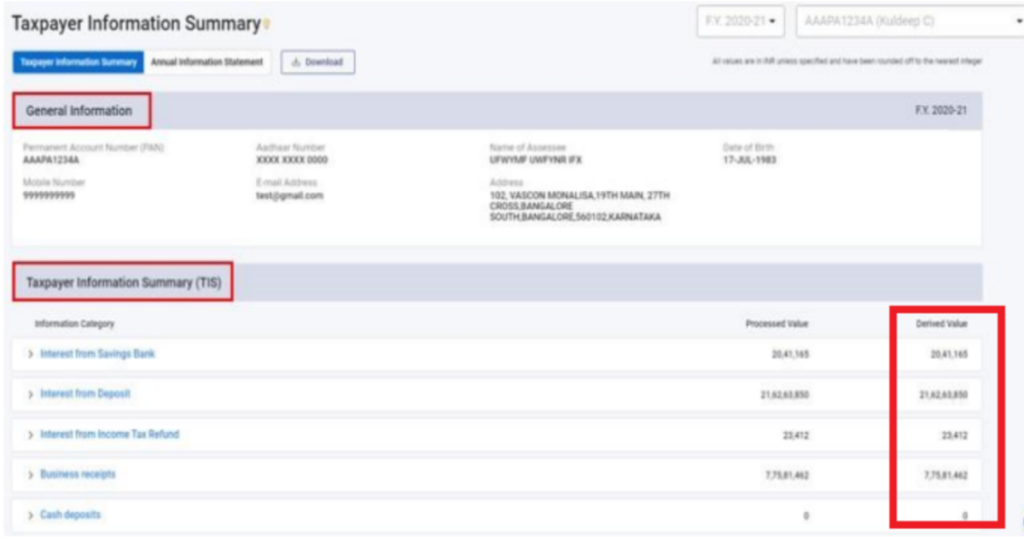
Read more: Features and Benefits of the New Income Tax Portal
What Happens After Submitting Feedback on AIS Information?
Once you submit feedback on the AIS information, the following actions will occur:
- Feedback Display: The feedback you provided will be shown alongside the information in the AIS. This allows you to see the modifications made and compare them with the originally reported values.
- Activity History Update: The activity history tab will be updated with the details of your feedback submission. This helps you keep track of the actions taken and any changes made.
- Acknowledgement Receipt: You will have the option to download an Acknowledgement Receipt for your feedback submission. This serves as proof that your feedback has been received and processed.
- Email and SMS Confirmation: You will receive email and SMS confirmations confirming the successful submission of your feedback. This ensures that you have a record of your submission and can refer to it if needed.
How to Register on AIS App?
The Income Tax department has launched the AIS for Taxpayer mobile app, providing convenience to taxpayers. The app allows easy access to tax-related information on the Annual Information Statement. It can be downloaded for free from the Google Play Store and Apple App Store.
To register and set up the AIS for Taxpayer app, follow these steps:
Step 1: Download the AIS for Taxpayer App from your app store.
Step 2: Enter your PAN number, Date of Birth, and preferred login ID.
Step 3: Verify your PAN, date of birth, mobile number, and email ID using OTP (One-Time Password).
Step 4: Set a 4-digit MPIN (Mobile Personal Identification Number).
Step 5: Confirm the MPIN by re-entering it in the provided field.
Step 6: Click on the “Submit” button.
Step 7: Use the MPIN to log in to the app.
The app displays various financial transactions like TDS, TCS, interest, dividends, share transactions, tax payments, refunds, and foreign remittances. Taxpayers can track and monitor these transactions, calculate tax liability, and ensure compliance.
Is There a Difference Between AIS and Form 26AS?
The Annual Information Statement (AIS) and Form 26AS have different purposes and provide different information. Form 26AS mainly details property purchases, big investments, and TDS/TCS transactions. On the other hand, AIS is more detailed and includes information like savings account interest, securities and property transactions, foreign remittances, and deposit interest.
For example, let’s say you earned Rs 5,000 in savings account interest and Rs 50,000 in fixed deposit interest from TBT bank. Form 26AS would only show the Rs 50,000 deposit interest subject to TDS. But AIS would show both transactions and provide extra details like the bank name, account type and account number. AIS also covers TDS/TCS transactions,, tax payments, refunds, Statement of Financial Transaction (SFT) information and other financial details.
Note: AIS doesn’t include GST information, while Form 26AS helps verify GST turnover based on Form GSTR-3B details.
In conclusion, the Annual Information Statement (AIS) is a document that taxpayers receive to give them a detailed summary of their financial information for a specific tax year. It includes things like transactions, income, and remittances from various sources. The purpose of the AIS is to make sure taxpayers have the correct and complete information they need to comply with tax regulations. If there are any mistakes or discrepancies in the AIS, taxpayers can provide feedback to get them corrected. The AIS also comes with helpful features like simplified summaries, different download options, and an online feedback platform. By using the AIS, taxpayers can easily access and understand their financial information, file their tax returns accurately, and avoid potential penalties.
Glossary:
TIS: The Taxpayer Information Summary (TIS) in the AIS provides a summary of information for taxpayers. It shows the total values of different types of information, such as Salary, Interest, Dividend, and more. The values shown are processed values (after removing duplicates) and derived values (considering taxpayer feedback). This summary helps taxpayers understand the overall information available to them.
Within the TIS, you will find:
- Information Category: The different types of information, like Salary, Interest, Dividend, etc.
- Processed Value: The total value of the information after removing any duplicate entries.
- Derived Value: The value obtained after considering the taxpayer’s feedback and the processed information.
- Information Details: For each information category, you can see additional details like the source of the information, a description of the information, and the amounts reported by the source, processed by the system, and accepted by the taxpayer.
The TIS is designed to provide taxpayers with a clear overview of the information available in different categories, making it easier to understand their tax-related details.
AIS: The Annual Information Statement (AIS) is a document that provides taxpayers with a clear and comprehensive overview of their financial information. It is based on Form 26AS, which contains details like tax deductions, income, and other financial transactions. The AIS aims to simplify the process of understanding and managing one’s financial information, promoting voluntary compliance, and discouraging non-compliance. By providing taxpayers with complete and accurate information, the AIS helps ensure transparency and accountability in the tax filing process.
TDS: TDS is a tax collection mechanism implemented by the government where a certain percentage of tax is deducted by the payer at the time of making payments to the payee. The deducted tax amount is then remitted to the government on behalf of the payee. TDS is applicable to various types of payments such as salary, interest, rent, professional fees, etc. It ensures that tax is collected in a timely manner and helps in preventing tax evasion. The deducted tax amount is reflected in the Annual Information Statement (AIS) and is considered while filing income tax returns.
Disclaimer: Nothing on this blog constitutes investment advice, performance data or any recommendation that any security, portfolio of securities, investment product, transaction or investment strategy is suitable for any specific person. You should not use this blog to make financial decisions. We highly recommend you seek professional advice from someone who is authorised to provide investment advice.


